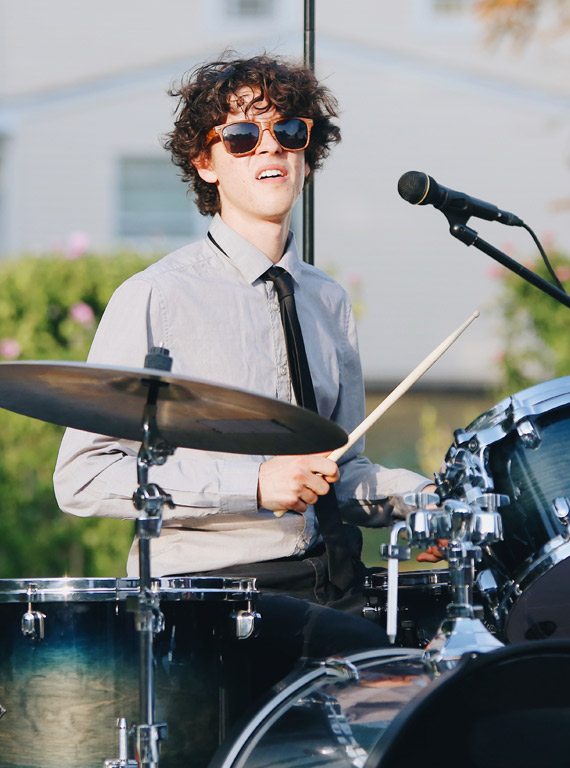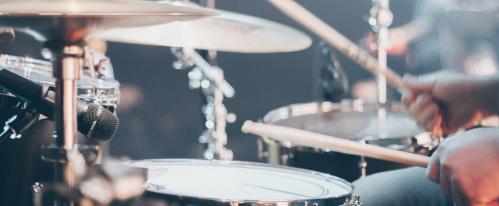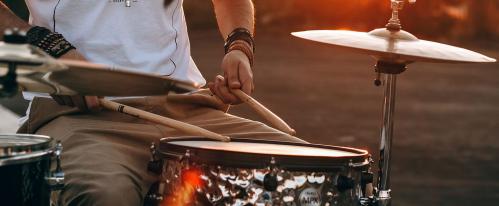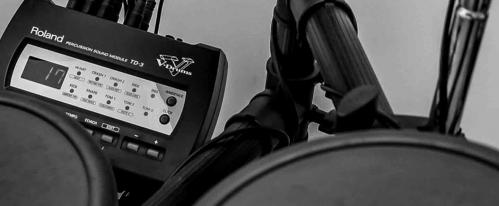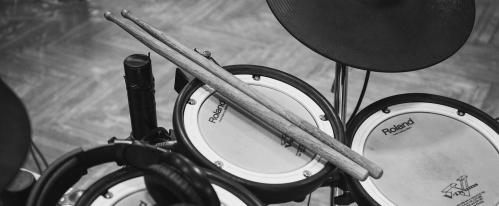WE SHOW YOU HOW TO CHOOSE DRUMSTICKS AND EXPLAIN THE DIFFERENCES BETWEEN DRUMSTICK SIZES, WEIGHT AND WHAT THOSE LETTERS AND NUMBERS MEAN
Wondering how to choose drumsticks? Need to know what the difference between drumsticks are? Look no further. Here's our handy guide to choosing drum sticks and a guide on drum stick sizes! Behind every great singer is a great guitarist, and behind every great guitarist is an even greater drummer. But to be a great drummer you've got to have the right sticks, so which pair of drumsticks are the best?
What style of taper, length, or wood type should you choose? Figuring out how to choose drumsticks doesn't have to be stressful! It should be fun! So in this blog we're going to give you a complete guide to drumsticks, including drumstick sizes explained and more.
Let's look at the differences in drumsticks and some various types of drumsticks up close so you can make the right decision.
Watch our Guide to Choosing Drum Sticks video
HOW DOES THE TIP SHAPE, LENGTH & TAPER AFFECT THE DRUMSTICK?
In this section we're going to look at how the following parts of a drum stick affect the drumstick, your playing and sound:
- Taper on a drumstick
- Length of a drumstick
- Tips on a drumstick

WHAT IS THE TAPER ON A DRUMSTICK & HOW DOES IT AFFECT SOUND?
Taper is the part of the stick where the shoulder (where the taper begins) thins to the tip. A long taper produces flick and flex with a faster response, while a short taper has a slower response with added strength. The length of the taper affects the overall balance of the stick, which will affect how you play.
HOW DOES THE LENGTH OF A DRUMSTICK AFFECT SOUND?
The length of the drum stick affects how easily a drummer can reach around the kit. A longer stick will give you more reach around the kit with a faster stick response compared to a shorter stick which will restrict reach but give the drummer more power and strength.
HOW DO THE DIFFERENT TIPS ON A DRUMSTICK AFFECT THE SOUND?
Tip Shape and the tip of the stick is important as it affects the sound made by the cymbal. Different tips work well for different styles. The tip of the drum stick is the part that hits the cymbal and the drum. You have two main tip types: Wood and Nylon, both of which produce different sounds. A nylon tip will produce a brighter, more aggressive attack which makes it perfect for Rock and Metal. However, a wooden tip is better for all-rounded players as you can dictate the attack more. When thinking about how to choose drumsticks, you should consider the different tips. In summary, these are all the different styles of drumstick tips here:
- Tear Drop - this shaped tip produces a deep, warm cymbal sound. Great for all styles.
- Barrel - this tip produces a wide sound. Great for Rock and Pop
- Small Round - this tip produces a brighter cymbal sound. Great for Jazz and Funk.
- Large Round - this tip produces a "fatter" sound. Great for Rock and Metal
- Acorn - provides a fuller, bigger sound.
- Ball tips - articulate, ideal for those who play intricate, delicate beats.
- Nylon - this tip produces the brightest sound and are the most durable. Great for added projection and cymbal definition.
DIFFERENT DRUMSTICK WOODS EXPLAINED - KEY BENEFITS, SOUND DIFFERENCES BETWEEN DRUMSTICK WOOD

The type of wood used in a drumstick is key to how the drum stick responds, and therefore how the drum sounds. Different wood types also contribute to your drumsticks response and durability. When you're wondering how to choose drumsticks, wood plays a massive part! In summary, these are key differences in drum stick woods and how they affect tone:
- Maple is the lightest wood used in drum stick manufacturing. It makes the stick very light, easy to control and gives a fast response. Although Maple is not as durable as Hickory or Oak due to its light feel it means drummers can have a larger, thicker stick without the added weight. Light as a feather, great for Jazz/Funk/Pop players.
- Hickory is the most common wood used in manufacturing drum sticks. It makes the stick very rigid and durable allowing for an increased attack around the kit. An all-round classic!
- Oak is the most durable wood used in drum stick manufacturing. It makes the stick very rigid and extremely durable allowing for an increased attack around the kit. A must for drummers who break sticks.
- Birch is the heaviest wood used in drum stick manufacturing. It makes the stick very dense and provides a heavier weight, feel, and durability. Similar to Thor’s hammer but great for control.
- Polyurethane is extremely durable, but not as 'natural' feeling as a wooden drumstick. These are great for speed drummers and those who go through tonnes of sticks!
There are many different types of drum stick materials but these are the five main types that are commonly known as the best for all-round playing.
DRUM STICK SIZES EXPLAINED - WHAT DO THE NUMBERS AND LETTERS ON DRUMSTICKS MEAN?
In summary, the numbers refer to the weight and thickness of a stick, whereas the letters are used to represent their application: A was an "orchestra" model, B was a "band" model, such as a concert band and S was a "street" model, for marching bands, whereas the letter D was used for "dance" bands. We go into more detail below.
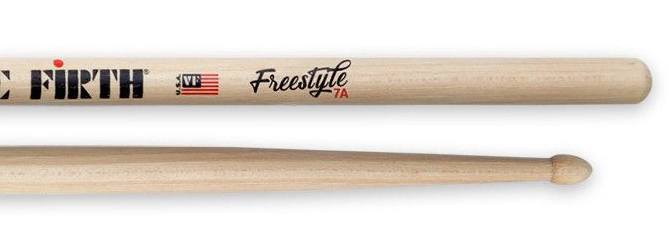
What Do The Numbers On Drumsticks Mean?
In summary, the numbers refer to the diameter of the drumstick, or "thickness". The lower the number, the thicker the stick. Different types of drum sticks will have different shapes and feel. For example, a 7A stick is thin, a 5A stick is slightly thicker and a 2B stick is the thickest stick available. As a rule of thumb, it's best to think that the higher numbers are designed for more delicate work, whereas the lower numbers are designed for the heavy beats! The most common numbers are 7, 5 and 2 although you can get 1, 3, 8 and 9 sticks. Brands are starting to develop their own versions of these sizes, so it's best trying out a range to see what's best for you.
What Do The Letters On Drumsticks Mean?
In summary, the letters used to refer to the recommended application.
- A for "orchestra" model
- B for a "band" model such as a concert band
- S was a "street" model designed for marching bands
- D was used for "dance" bands
Although these applications are now a little outdated, it gives you an idea of why they were developed and what they might sound like.
Drum Stick Lengths Explained
Drum stick dimensions are as follows (general rule):
- Number 1 sticks are usually 16.75" to 17.25" long
- Number 2 is 16.00" to 16.50" long
- Number 3 drum sticks are 15.50" to 17.00" long
- Number 5 sticks are 16.00" long
- Number 7 is 15.00" to 15.75" long
- Number 8 is 16.00" to 16.50" long
- Number 9 is 16.00" to 16.50" long
What Are The Most Common Drumsticks & DrumStick Sizes?
There are a range of different sticks but 5A, 5B and 2B are the most commonly used sizes. Use this drumstick size chart to get an idea of what the letters and numbers mean - here's a short description of each stick:
- 5A – This is the standard drumstick
- 3A – Thicker than 5A, slightly longer
- 5B – Shorter overall, but thicker than 3A sticks
- 7A – A thin drum stick perfect for jazz or softer applications
- 8D – Same as 7A but longer
- 1A – The longest stick available
- 2B – The thickest stick available - perfect for metal
5A vs 5B Drumsticks: What's The Difference?
The difference between 5A drumsticks and 5B drumsticks is thickness. The 5A drumstick has a medium-weight and medium-length drumstick, whereas the 5B is a thicker drumstick used for rock drumming.
What Size Drum Sticks Should I Use?
In summary, 5A sticks are best for beginners as they are a great all-rounder, 2B sticks are best for practising as they help strengthen your hands and encourage speed when you go back to regular size sticks. 5B sticks are the universal standard and widely available. Here's a quick guide to drum stick sizes for beginners - perfect for choosing drumsticks.
5A drum stick – Classic model, classic weight. The all-round feel and balance of this stick works for most drummers. Suited for all playing styles from Rock to Jazz and available from all major stick companies. For drummers who like more reach around the kit the 'Extreme' or 'X' 5A models are the perfect stick.
5B drum stick – Classic model, with a slightly heavier weight than the 5A. The all-round feel and balance of this stick works for drummers who like a stick with a heavier feel. Suited for playing styles like Rock, Funk and Metal and available from all major stick companies.
2B drum stick – Classic model, with a slightly heavier weight than the 5B. The all-round feel and balance of this stick works for drummers who like a heavier stick with a heavier forward feel. Suited for playing styles like Rock and Metal and available from all major stick companies.
Recommended Applications & Drumming Styles For Certain Drum Sticks
- 5A – A standard, beginner stick, great all-rounder
- 3A – Thicker than 5A, slightly longer
- 5B – For those who want a shorter, thicker stick
- 7A – Best for Jazz
- 8D – For Jazz, with extra reach for bigger setups
- 1A – For those who want the longest reach
- 2B – best for metal and practising
Beginners should really start with the 5A stick as they give you a great starting point. You can then branch out to other options when you start developing a style of your own or continue using 5A, it's up to you. At the end of the day, we recommend trying out a range for yourself to find what's best for you. We hope our guide on how to choose drumsticks and guide to drum stick sizes has been helpful.
Remember, we have dedicated drum experts in each PMT store, so speak to our experts today and let us help you find the right drum stick for your needs, or chat to us about the best drum stick sizes for your playing style.
Updated 17/11/2021

